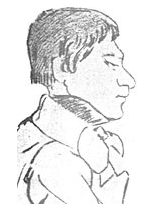Kieseritsky Lionel Adelberto Bagration Felix (01.01.1806 – 18.05.1853)
 Born in Tartu, Kieseritsky was supposed to follow his father as an advocate, but instead, he became a teacher of mathematics. He was becoming increasingly devoted to chess and sailed to France in 1839 just in time to meet Louis Bourdonnais, who struggled to give him knight odds. Settled in the Cafe de la Régence, Kieseritsky gave lessons for five francs an hour or played a game for the same fee. He had a thorough knowledge of openings, a receptive memory, and a rich imagination. His strength was shown most when giving great odds to weak players, but against Masters, he was less convincing. He is most famous for his variation of the King’s Gambit and for losing the so-called Immortal Game to Adolf Anderssen in London, 1851.
Born in Tartu, Kieseritsky was supposed to follow his father as an advocate, but instead, he became a teacher of mathematics. He was becoming increasingly devoted to chess and sailed to France in 1839 just in time to meet Louis Bourdonnais, who struggled to give him knight odds. Settled in the Cafe de la Régence, Kieseritsky gave lessons for five francs an hour or played a game for the same fee. He had a thorough knowledge of openings, a receptive memory, and a rich imagination. His strength was shown most when giving great odds to weak players, but against Masters, he was less convincing. He is most famous for his variation of the King’s Gambit and for losing the so-called Immortal Game to Adolf Anderssen in London, 1851.
Comparisons were inevitably made between Kieseritsky and the last great native French Master, Pierre Charles Fournier de Saint-Amant. Of the three games they played against each other, as far as we know, each won one. The comparisons were much in Saint-Amant’s favor.
Rev. William Wayte wrote about them in the British Chess Magazine of December 1883 and dismisses Kieseritsky as ‘essentially a gallery player, dealing chiefly in fireworks against weak opponents, while Saint-Amant was more solid, and could be equally brilliant on occasion’.
In 1850 Kieseritsky played a colossal number of games in a match against John William Schulten, which he won by +107-34=10. He returned to London in 1851 to take part in the 1851 tournament but had the misfortune to be drawn against Anderssen in the very first round and lost to him by ½:2½. Since this was a knock-out tournament, Kieseritsky had no further interest in the event. Henry Buckle, who came too late to play in the tournament, played a couple of matches after the event. One was against Kieseritsky, who revenge himself for his previous defeat by winning the match +2-1=0.
Kieseritsky’s health gave way shortly after his return to Paris and he died in poverty in the Hotel de Dieu, the charity hospital for the insane, in 1853. Sadly an appeal to the Paris chess-players for funds for his burial was not successful and he was buried in a pauper’s grave.
Kieseritsky was also an excellent annotator and writer on the game and he founded the chess magazine La Régence to replace Saint-Amant’s Le Palamède, which he edited from 1849 to 1851. Use of an obscure notation that he devised limited its success. A similar failure to communicate also hampered his chess lessons, which were given in a mixture of mathematical and musical notations, as he was a skillful musician. He also invented a three-dimensional form of chess but had no support for it. His pale, spongy complexion, unattractive appearance, and sharp tongue made him a difficult man to like.
Kieseritsky published Cinquante Parties, Paris 1846. (source: The Oxford Companion to Chess).



